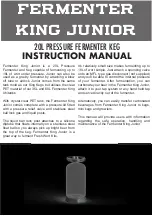
Chapter 4
Analog Input
©
National Instruments Corporation
4-3
For more information abo
u
t setting ranges, refer to the
NI-DAQmx Help
or
the
LabVIEW Help
in version 8.0 or later.
The following table shows the inp
u
t ranges and resol
u
tions s
u
pported by
USB-621
x
devices.
Analog Input Ground-Reference Settings
USB-621
x
devices s
u
pport the following analog inp
u
t gro
u
nd-reference
settings:
•
Differential Mode
—In DIFF mode, USB-621
x
devices meas
u
re the
difference in voltage between two AI signals.
•
Referenced Single-Ended Mode
—In RSE mode, USB-621
x
devices
meas
u
re the voltage of an AI signal relative to AI GND.
•
Non-Referenced Single-Ended Mode
—In NRSE mode, USB-621
x
devices meas
u
re the voltage of an AI signal relative to the AI SENSE
inp
u
t.
The AI gro
u
nd-reference setting determines how yo
u
sho
u
ld connect yo
u
r
AI signals to the USB-621
x
device. For more information, refer to one of
the following sections depending on yo
u
r device:
•
Connecting Analog Input Signals on USB-6210/6211/6212 Devices
•
Connecting Analog Input Signals on USB-6215/6216/6218 Devices
Gro
u
nd-reference settings are programmed on a per-channel basis.
For example, yo
u
might config
u
re the device to scan 12 channels—fo
u
r
differentially-config
u
red channels and eight single-ended channels.
USB-621
x
devices implement the different analog inp
u
t gro
u
nd-reference
settings by ro
u
ting different signals to the NI-PGIA. The NI-PGIA is a
differential amplifier. That is, the NI-PGIA amplifies (or atten
u
ates) the
difference in voltage between its two inp
u
ts. The NI-PGIA drives the ADC
Input Range
Nominal Resolution Assuming
5% Over Range
–10 V to 10 V
320
μ
V
–5 V to 5 V
160
μ
V
–1 V to 1 V
32
μ
V
–200 mV to 200 mV
6.4
μ
V
















































